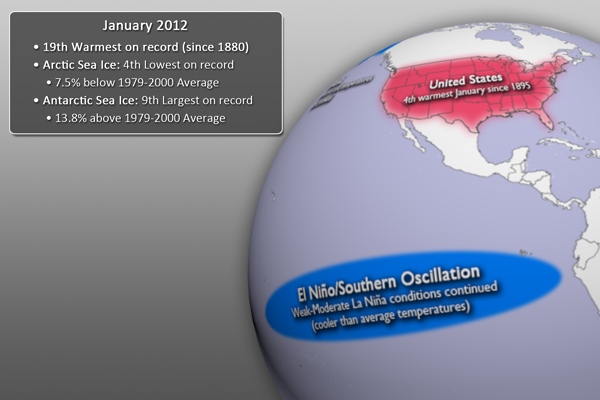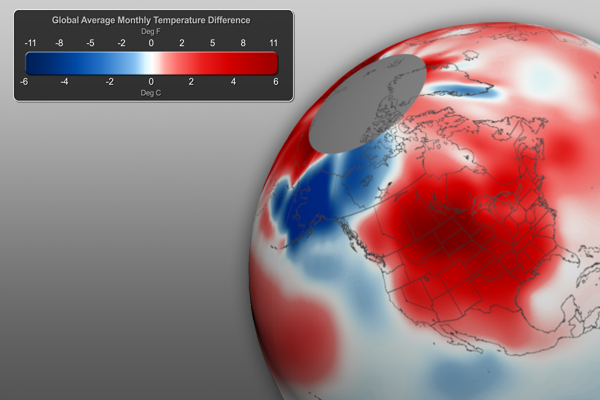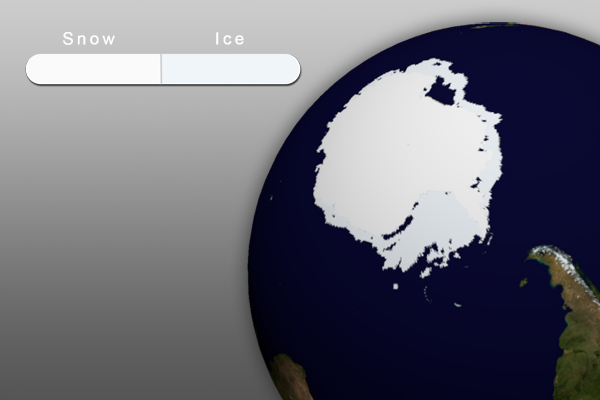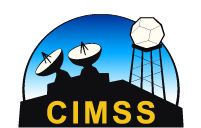Each month, around the middle of the month, we will provide information regarding the previous month’s climate, as well as the U.S. seasonal outlook for the coming months. Overall, preliminary data analysis suggests that January 2012 was the 19th warmest January on record. Major stories include a warm United States (but cold Alaska), La Niña, and low concentrations of Arctic sea ice. More detailed information follows:
- This dataset highlights some of the major January events from the National Climatic Data Center’s (NCDC) monthly global climate analysis. The events are noted below with more information.
- El Niño/Southern Oscillation (ENSO): Cooler than average waters in the eastern central Pacific Ocean mean that light to moderate La Niña conditions continue. It is expected that ENSO will become neutral before the Northern Hemisphere Summer. Click here for more information about La Niña and how it may impact the outlook for the forthcoming Winter season.
- United States: Parts of Alaska experienced record cold temperatures and snowfall. Meanwhile the contiguous U.S. had the fourth warmest January on record (since 1895). It was also the first January since 2006 in which none of the the contiguous states had below-average temperatures.
- Alaska’s record cold and the contiguous states’ warmth are both likely in conjunction with the negative phase of the Arctic Oscillation. Click here for more information about the Arctic Oscillation from the National Snow and Ice Data Center.
- Brazil: Heavy rains led to flooding and landslides in southeastern Brazil, killing 8 people and displacing 13,000 people from their homes. The southeastern states affected were Minas Gerais and Rio de Janeiro.
- United Kingdom: The UK had its warmest January since 2008. The average temperature was 1.3˚C (2.3˚F) above the 1971-2000 average.
- Spain: Spain experienced its driest January in 50 years, with rainfall (2.1 cm, 0.83 in) across the country at 70% below the January average.
- Germany: While Spain had an usually dry January, Germany experienced its sixth wettest January since records began in 1881. Average precipitation for January 2012 was 10.5 cm (4.14 in), 72.8% above the monthly average.
- Philippines: Heavy rainfall since mid-December led to a mudslide on January 5th on Mindanao Island. The mudslide killed around 30 people. 40 others are still missing.
- Australia: In Australia, the average maximum temperature was 0.43˚C (0.77˚F) below average, making it the coolest January since 2000 (13th since records began in 1950). On the other hand, the average minimum temperature was near normal.
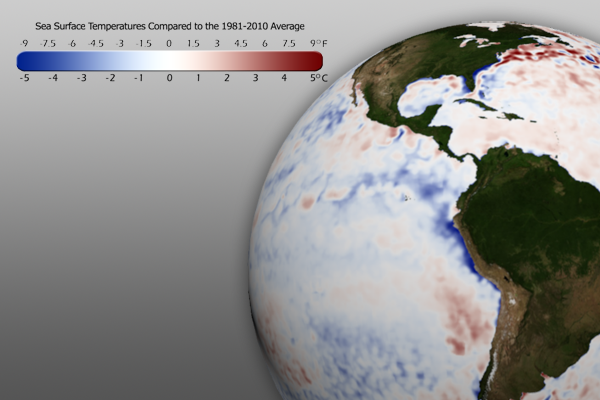 Sea Surface Temperature Anomaly
Sea Surface Temperature Anomaly
- The real-time sea surface temperature anomaly dataset is a great way to visualize the cooler than normal waters in the eastern central Pacific ocean. This indicates the La Niña pattern mentioned above.
- Remember that the blues indicate cooler than average temperatures and reds indicate warmer than average temperatures (white: average).
- Using the real-time Monthly Temperature Anomalies dataset is a great way to convey where some of the warmer and cooler than average areas were in January.
- The combined global land and ocean average surface temperature for January 2012 was the 19th warmest on record at 12.39˚C (54.30˚F), which is 0.39˚C (0.70˚F) above the 20th century average.
- Aside from helping to illustrate seasonal changes, the real-time Snow and Ice Cover dataset is a great way to convey sea ice change through time, including discussing how the current sea ice extent compares to other noteworthy years.
- The Arctic sea ice extent in January was the fourth lowest on record. The extent was 7.5% below the 1979-2000 average.
- In Antarctica, the January sea ice extent was the 9th largest on record, at 13.8% above the 1979-2000 average.
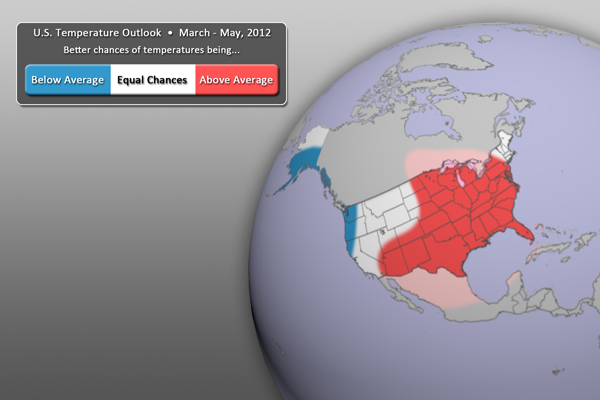 U.S. Climate Outlook – Temperature
U.S. Climate Outlook – Temperature
- Weak to moderate La Niña conditions are expected to influence the U.S. temperature outlook (see below).
- For the March – May period, warmer than normal temperatures are expected across much of the contiguous United States, from Arizona to the northern plains, to Florida and up through the Mid Atlantic region.
- By contrast, cooler than normal temperatures can be expected for the Pacific Northwest, north into southern Alaska.
- All other locations (in white) have equal chances of being warmer or cooler than normal.
- Outlook by NOAA’s Climate Prediction Center (CPC)
- In its forecasts, the CPC uses a wide variety of models in conjunction with looking at climate variables (like La Niña).
- It should be noted that areas in the “warmer than normal” region may still have cold winter days. This outlook only suggests that after the three months (March, April, and May) are over, those areas in the “warmer than normal” region are more likely to have experienced warmer than normal average temperatures. The same is true for the “cooler than normal” and “equal chances” regions.
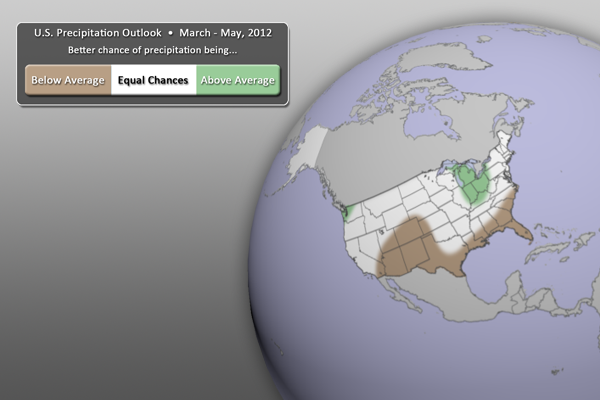 U.S. Climate Outlook – Precipitation
U.S. Climate Outlook – Precipitation
- For the next three months (March – May), drier than normal conditions are expected for much of the southwest states, as well as the southern parts of the southern states, from Texas and into the southern Atlantic coastal states. as well as the southeast coastal states.
- Wetter than normal conditions, however, are expected for extreme western Washington state, as well as the Great Lakes/Ohio Valley region.
- All other locations (in white) have equal chances of being wetter or drier than normal.
- Outlook by NOAA’s Climate Prediction Center (CPC)
- In its forecasts, the CPC uses a wide variety of models in conjunction with looking at climate variables (like La Niña).
- It should be noted that areas be in the “drier than normal” region may still have rain and snow storms. This outlook only suggests that after the three months (March, April, and May) are over, those areas in the “drier than normal” region are more likely to have experienced drier than normal averages. The same is true for the “wetter than normal” and “equal chances” regions.
Helpful Resources for More Information
- http://www.ncdc.noaa.gov/oa/ncdc.html National Climatic Data Center (NCDC)
- http://www.ncdc.noaa.gov/teleconnections/enso/enso-tech.php About ENSO (El Niño/La Niña)
- http://www.ncdc.noaa.gov/sotc/global/ NCDC’s Global Climate Report
- http://www.pmel.noaa.gov/tao/elnino/la-nina-story.html About La Niña
- http://www.cpc.ncep.noaa.gov/ Climate Prediction Center (CPC)
- http://nsidc.org/arcticmet/patterns/arctic_oscillation.html About AO (Arctic Oscillation)
Where do I find the datasets?
- First, check your SOS system to make sure it’s not already in the EarthNow category. There should also be an ‘earthnow.sos’ playlist file (you’ll need to add that to your sosrc folder).
- If not, you can download the datasets and playlist.sos files from this FTP Site.

